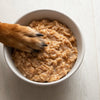Understanding Postpartum Weight Changes in Dogs: Do Dogs Lose Weight After Giving Birth?
- Houndsy
Table of Contents
- Introduction
- The Physical Changes of a Dog After Giving Birth
- The Nutritional Needs of a Nursing Dog
- Monitoring Weight and Health
- Supporting Recovery After Weaning
- Conclusion
- FAQ
Introduction
Did you know that a dog's body undergoes significant changes during and after pregnancy, impacting their overall health and weight? According to veterinary experts, a nursing mother dog may need to consume up to three times her usual food intake to support her puppies. This drastic shift in dietary needs leads many pet owners to wonder: do dogs lose weight after giving birth?
This question is particularly important for pet owners who want to ensure their furry friends are healthy and well-cared for during this critical time. Understanding the nuances of a dog's weight management postpartum can make a significant difference in their recovery and overall well-being. In this blog post, we will delve into the changes a female dog's body experiences after giving birth, how those changes affect her weight, and what measures we can take to support her health during this period.
By the end of this article, you will have a comprehensive understanding of the factors influencing a dog’s weight after giving birth, the nutritional needs of a nursing mother, and practical tips for ensuring her recovery. We invite you to reflect on your own experiences with your pets as we dive into this essential topic.
The Physical Changes of a Dog After Giving Birth
Understanding Postpartum Weight Fluctuations
When dogs give birth, they often experience immediate physical changes, including weight loss. During pregnancy, a mother dog accumulates weight primarily due to the growing puppies and increased food intake. However, after giving birth, she may lose weight rapidly, especially if she is nursing multiple puppies.
-
Immediate Weight Loss: After delivery, a mother dog may lose around 10-15% of her body weight. This loss occurs due to several factors:
- Fluid Loss: During labor, dogs lose fluids which can lead to immediate weight loss.
- Puppy Weight: The weight of the puppies is no longer being carried, leading to a noticeable reduction in body mass.
- Postpartum Recovery: The mother’s body begins to expel the placenta and any remaining fluids, contributing to weight fluctuations.
- Nursing Demands: As the mother begins nursing, her caloric needs significantly increase. A nursing dog may require up to three times her usual food intake, depending on the size of the litter. This increased demand can lead to weight loss if her nutritional needs are not met.
- Long-Term Changes: Over time, a dog may regain weight or stabilize at a new weight after weaning her puppies. Factors such as the size of the litter, the dog’s age, and her overall health play a role in how quickly she returns to her pre-pregnancy weight.
What to Expect During the Weaning Process
The weaning process generally begins around four weeks after birth. As puppies start to eat solid food, their dependence on their mother decreases. During this time, the mother dog’s appetite may also decline, leading to additional weight loss if not properly managed.
- Gradual Decrease in Nutritional Needs: As the puppies gradually consume less milk, the mother’s caloric intake should also be adjusted to prevent excessive weight gain.
- Monitoring Health: It's essential to monitor both the mother and her puppies for signs of malnutrition or health issues during this transition.
The Nutritional Needs of a Nursing Dog
Importance of a Balanced Diet
To support a nursing dog effectively, it's vital to ensure she receives a well-balanced, nutrient-dense diet. This helps maintain her health and ensures she can produce sufficient milk for her puppies. Here are key considerations:
-
High-Quality Puppy Food: Vets often recommend high-quality puppy food for nursing mothers as it is formulated to meet the elevated energy and nutritional needs during this period. Nutritional elements to focus on include:
- Protein: Essential for milk production and overall health.
- Fat: Provides concentrated energy that is crucial for nursing.
- Vitamins and Minerals: Important for both the mother’s health and the healthy development of her puppies.
- Hydration: Adequate hydration is equally important. A nursing dog should have constant access to fresh water to support milk production. Dehydration can lead to decreased milk supply and affect her health adversely.
Adjusting Food Intake
As we mentioned earlier, a nursing dog may need significantly more food than usual. Here are some practical tips for adjusting her diet:
- Frequent Smaller Meals: Instead of one or two large meals, providing multiple smaller meals throughout the day can help her meet her increased caloric needs without overwhelming her digestive system.
- Free-Choice Feeding: Some pet owners opt for free-choice feeding, allowing the mother dog to have unlimited access to dry kibble, which can be beneficial during nursing.
Monitoring Weight and Health
Assessing Weight Changes
Weight management is crucial after giving birth. Here are some tips for monitoring a nursing dog’s weight effectively:
- Regular Weigh-Ins: Weighing your dog weekly can help determine if she is losing too much weight or regaining it too slowly.
- Body Condition Scoring: Familiarize yourself with body condition scoring scales for dogs to assess whether she is underweight, overweight, or at an ideal weight.
Recognizing Signs of Health Issues
In addition to monitoring weight, it’s essential to observe your dog for any signs of health complications during the postpartum period. Common issues include:
- Mastitis: This infection of the mammary glands can lead to redness, swelling, and pain in the teats. If you notice any of these symptoms, it’s important to consult with your veterinarian immediately.
- Metritis: An inflammation of the uterus that can occur post-birth. Symptoms may include a foul-smelling discharge, fever, and lethargy.
- Eclampsia: Also known as milk fever, this condition can occur due to a drop in calcium levels and can be life-threatening. Symptoms include muscle tremors, restlessness, and seizures.
Supporting Recovery After Weaning
Once the puppies are weaned, a mother dog's nutritional needs will begin to stabilize, and she can gradually return to her pre-pregnancy diet. However, this transition should be approached with care.
- Gradual Diet Adjustment: Slowly decrease the caloric intake to match her normal level, keeping in mind that she may need slightly more than her original amount if she has lost weight during nursing.
- Encouraging Exercise: Once the mother dog has recovered from nursing, regular exercise is essential to help her regain her strength and maintain a healthy weight. However, postpartum exercise should be gradual and tailored to her condition.
- Monitoring for Changes: Continue to monitor her weight and overall health, as each dog’s recovery can vary based on a range of factors, including age, health status, and the size of the litter.
Conclusion
The journey of motherhood significantly impacts a dog's body, leading to weight loss after giving birth due to several factors including nursing demands and changes in feeding habits. Understanding these changes and how to support a nursing dog through proper nutrition and care is crucial for her recovery and the well-being of her puppies.
As pet owners, we have the responsibility to ensure that our furry friends receive the care they need during this critical time. Whether it's adjusting their diet or consulting with a veterinarian, proactive measures can make a significant difference in a dog's health postpartum.
By taking these steps, we can help our dogs transition smoothly through the challenges of motherhood, allowing them to regain their strength and health.
If you’re looking to simplify your pet care routine, consider exploring the Houndsy Kibble Dispenser to ensure your dog receives the proper nutrition effortlessly— Order Now.
FAQ
Do dogs lose weight after giving birth?
Yes, it is common for dogs to lose weight after giving birth due to fluid loss, the weight of the puppies, and increased nutritional demands while nursing.
How much should a nursing dog eat?
A nursing dog may require two to three times her normal food intake depending on her litter size. High-quality puppy food is often recommended.
What signs should I watch for after my dog gives birth?
Monitor for signs of mastitis, metritis, and eclampsia. Additionally, keep an eye on her appetite and energy levels.
How can I help my nursing dog regain weight?
Provide a nutrient-dense diet, ensure she stays hydrated, and gradually increase her caloric intake as her puppies wean.
When can I return my dog to her normal diet?
Once the puppies are fully weaned, you can gradually transition your dog back to her pre-pregnancy diet, keeping in mind her specific needs.













